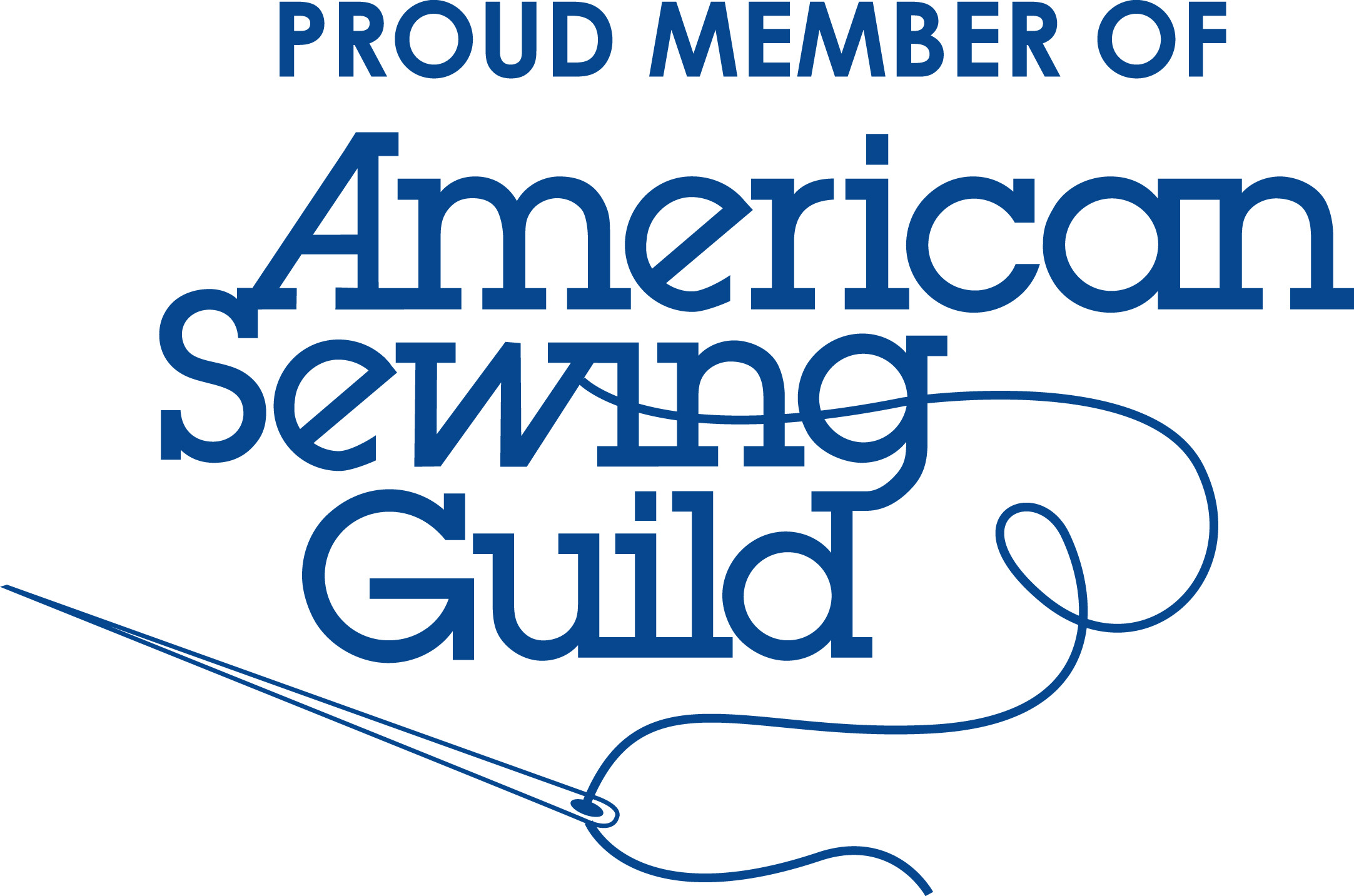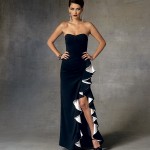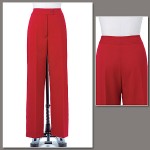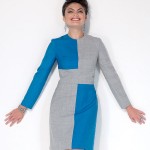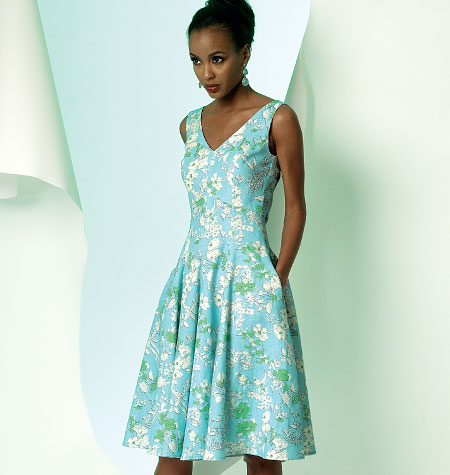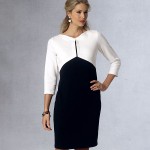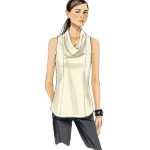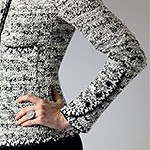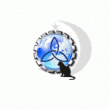Choosing the fabric for your sewing project is the first important part of the sewing process. I know how it works…you see a bolt of fabric and it hits…an image pops into your mind of you wearing a dress, pants, etc. made from this gorgeous fabric and you feel that you better purchase it right now before its gone! However… heed a warning from someone who has made just about every mistake I have heard or read about – a fabric can make or break you in the sewing process! Hence, it helps to know your fabric before you begin walking through the aisles of a fabric store. 🙂
There are many websites that provide plenty of information on fabrics but to make it more convenient for you, I decided to begin developing my own fabric dictionary here; a primer for now though with time I envision it to be much more.
B |
Battenberg – Coarse form of renaissance lace either hand or machine made – from linen braid or tape and linen thread, assembled together to form various designs.
Batiste – A medium-weight, plain weave fabric, usually made of cotton or cotton blends. End-uses include blouses and dresses.
Bengaline – A sturdy warp-faced fabric with pronounced crosswise ribs formed by bulky, coarse, plied yarns or rubber thread. Originating in Bengal, India, it is used mainly in coatings, mourning ensembles, and women’s headwear. When cut to ribbon widths, it is called grosgrain.
Boucle – Knitted or woven fabric with characteristic looped or knitted surface that often resembles a spongy effect. The term also applies to a variety of looped, curled or slubbed yarns. In French, boucle means “buckled” or “ringed”.
Broadcloth – Originally a silk shirting fabric so named because it was woven in widths exceeding the usual 29″. Today, broadcloth refers to a tightly woven, lustrous cotton or polyester/cotton blend fabric in a plain weave with a crosswise rib. It resembles poplin, but the rib is finer, and broadcloth always has more crosswise yarns (picks) than poplin.
Brocade – A heavy, exquisite jacquard type fabric with an all-over raised pattern or floral design. Common end-uses include such formal applications as upholstery, draperies, and eveningwear.
Burn-out – A brocade-like pattern effect created on the fabric through the application of a chemical, instead of color, during the burn-out printing process. (Sulfuric acid, mixed into a colorless print paste, is the most common chemical used.) Many simulated eyelet effects can be created using this method. In these instances, the chemical destroys the fiber and creates a hole in the fabric in a specific design, where the chemical comes in contact with the fabric. The fabric is then over-printed with a simulated embroidery stitch to create the eyelet effect. However, burn-out effects can also be created on velvets made of blended fibers, in which the ground fabric is of one fiber like a polyester, and the pile may be of a cellulosic fiber like rayon or acetate. In this case, when the chemical is printed in a certain pattern, it destroys the pile in those areas where the chemical comes in contact with the fabric, but leaves the ground fabric unharmed.
C |
Camel Hair – Wool-like underhair of the Bactrian camel, a two-humped pack-carrying species that is lustrous and extremely soft. Because it is expensive, often used in blends with wool for coats, suits, sweaters, blankets, and oriental rugs. Natural colors range from light tan to brownish black. Classified as wool under the Wool Products Labeling Act.
Canvas – Cotton, linen, or synthetic fabric made with a basic plain weave in heavy and firm weight yarns for industrial or heavy duty purposes. Also referred to as “duck”, although the term “canvas” usually relates to the heavier, coarser constructions.
Cashmere – A luxury fiber obtained from the soft fleecy undergrowth of the Kashmir goat of Tibet, Mongolia, China, Iran, Iraq, and India. Most commonly used in sweaters, shawls, suits, coats, and dresses.
Challis – One of the softest fabrics made. Named from the American Indian term “shalee”, meaning soft. A lightweight, soft plain weave fabric with a slightly brushed surface. The fabric is often printed, usually in a floral pattern. Challis is most often seen in fabrics made of cotton, wool, or rayon.
Chevron – Term applies to herringbone weaves or prints in zigzag stripes.
Chiffon – A plain woven lightweight, extremely sheer, airy, and soft silk fabric containing highly twisted filament yarns. The term “chiffon” implies thinness, diaphanous, or gauze-like structure and softness. Originally made of silk, but today may be found in a wide variety of other manufactured fibers. The fabric, used mainly in evening dresses and scarves.
Corduroy – A fabric, usually made of cotton, utilizing a cut-pile weave construction. Extra sets of filling yarns are woven into the fabric to form ridges of yarn on the surface. The ridges are built so that clear lines can be seen when the pile is cut
Cotton – A unicellular, natural fiber that grows in the seed pod of the cotton plant. Fibers are typically 1/2 inch to 2 inches long. The longest staple fibers, longer than 1 1/2 inch, including the Pima and Egyptian varieties, produce the highest quality cotton fabrics.
Drawbacks:
Most cottons wrinkle easily unless treated with a special finish. Cotton also shrinks when laundered, so it’s important to preshrink cotton fabric before sewing. Cotton is also weakened by excessive exposure to sunlight.
Care requirements:
Most cotton fabrics can be laundered, but hand washing is recommended for some weaves (read your care label). Most white cottons can be bleached. Iron cotton fabrics slightly damp using a high temperature.
Examples of cotton fabrics:
Flannel, broadcloth, twill, damask, denim, poplin.
Crepe – A variety of lightweight fabrics characterized by a crinkly surface, obtained either via use of hard twist yarns, chemical treatments, weave, construction, or some form of embossing or surface treatment. Crepes are available today in an unlimited variety of fibers and blends, and in may different constructions.
Crepe-back Satin – A satin fabric in which highly twisted yarns are used in the filling direction. The floating yarns are made with low twist and may be of either high or low luster. If the crepe effect is the right side of the fabric, the fabric is called satin-back crepe.
Crinoline – A lightweight, plain weave, stiffened fabric with a low yarn count (few yarns to the inch in each direction). Used as a foundation to support the edge of a hem or puffed sleeve.
D |
Denim – A firm 2X1 or 3X1 twill weave fabric often having a whitish tinge obtained by using white filling yarns with colored warp yarns. Heavier weight denims, usually blue, are used for dungarees, work clothes, and men’s and women’s sportswear. Lighter weight denims have a softer finish and come in a variety of colors and patterns for sportswear.
Donegal Tweed – A medium to heavy, plain or twill weave fabric in which colorful yarn slubs are woven into the fabric. The name originally applied to a hand-woven woolen tweed fabric made in Donegal, Ireland. End-uses include winter coats and suits.
Dotted Swiss – A lightweight, sheer cotton or cotton blend fabric with a small dot flock-like pattern either printed on the surface of the fabric, or woven into the fabric. End-uses for this fabric include blouses, dresses, baby clothes, and curtains.
Duck – The name duck covers a wide range of fabrics. A tightly woven, heavy, plain-weave, bottom-weight fabric with a hard, durable finish. The fabric is usually made of cotton, and is widely used in men’s and women’s slacks, and children’s play clothes. The most important fabrics in this group are known as number duck, army duck, and flat or ounce duck.
E
Eyelet – A type of fabric which contains patterned cut-outs, around which stitching or embroidery may be applied in order to prevent the fabric from raveling. Often worked around with a buttonhole stitch.
F |
Faille – A glossy, soft, finely-ribbed silk-like woven fabric made from cotton, silk, or manufactured fibers.
Flannel – A medium-weight, plain or twill weave fabric that is typically made from cotton, a cotton blend, or wool. The fabric has a very soft hand, brushed on both sides to lift the fiber ends out of the base fabric and create a soft, fuzzy surface. End-uses include shirts and pajamas.
Flannelette – A medium-weight, plain weave fabric with a soft hand, usually made from cotton. The fabric is usually brushed only on one side, and is lighter weight than flannel. End-uses include shirts and pajamas.
G |
Gabardine – A tightly woven, twilled, worsted fabric with a slight diagonal line on the right side. Wool gabardine is known as a year-round fabric for business suiting. Polyester, cotton, rayon, and various blends are also used in making gabardine.
Gauze – A thin, sheer plain-weave fabric made from cotton, wool, silk, rayon, or other manufactured fibers. End-uses include curtains, apparel, trimmings, and surgical dressings.
Georgette – A sheer lightweight fabric, often made of silk or from such manufactured fibers as polyester, with a crepe surface, in which yarns are twisted both ways in the weave. End-uses include dresses and blouses.
Gingham – A medium weight, plain weave fabric with a dyed yarns in both warp and filling to achieve a plaid or check pattern. End-uses include dresses, shirts, and curtains.
H |
Herringbone (Herringbone Twill) – A variation on the twill weave construction in which the twill is reversed, or broken, at regular intervals, producing a zig- zag effect.
Horsehair – The long and lustrous hair taken from the mane and tail of horses. One of the most common uses is in blends with other fibers for hair canvas interfacings.
Houndstooth Check – A variation on the twill weave construction in which a broken check effect is produced by a variation in the pattern of interlacing yarns, utilizing at least two different colored yarns. This check pattern is often used in clear-finished worsted, woolen dress goods, etc.
J |
Jacquard – Woven fabrics manufactured by using the Jacquard attachment on the loom. This attachment provides intricate versatility in designs and permits individual control of each of the warp yarns. Thus, fabrics of almost any type or complexity can be made. Brocade and damask are types of jacquard woven fabrics.
Jersey Fabric – The consistent interlooping of yarns in the jersey stitch to produces a fabric with a smooth, flat face, and a more textured, but uniform back. Jersey fabrics may be produced on either circular or flat weft knitting machines.
L |
Lace – The term comes from the old French, las, by way of Latin, laquens, which means a noose, or to ensnare – rather well adapted to lace. A single yarn can produce a plaited or braided fabric or article since it will interlace, entwine, and twist in several directions to produce a porous material or lace.
Lamé – A woven fabric using flat silver or gold metal threads to create either the design or the background in the fabric.
Lawn – A light, fine cloth made using carded or combed, linen or cotton yarns. The fabric has a crease-resistant, crisp finish. Linen lawn is synonymous with handkerchief linen. Cotton lawn is a similar type of fabric, which can be white, solid colored, or printed.
Linen – A fabric made from linen fibers obtained from inside the woody stem of the flax plant. The term, linen, cannot be used except for natural fiber flax. The fiber length ranges from a few inches to one yard, with no fuzziness, does not soil quickly, and has a natural luster and stiffness. Linen fibers are much stronger and more lustrous than cotton. Linen fabrics are very cool and absorbent, but wrinkle very easily, unless blended with manufactured fibers. Linen is one of the oldest textile fibers.
Drawbacks:
Linen tends to wrinkle easily unless treated with a special finish. It can also shrink and soften if laundered. Linen also has poor elasticity – it tends to stretch without recovering its shape.
Care requirements:
Since linen fabrics can shrink or soften if laundered, dry-cleaning is usually recommended. Iron linen using a high temperature.
M |
Muslin – An inexpensive, medium weight, plain weave, low count (less than 160 threads per square inch) cotton sheeting fabric. In its unfinished form, it is commonly used in fashion design to make trial garments for preliminary fit. The equivalent British English term is toile.
O |
Organza – A crisp, sheer, lightweight plain weave fabric, with a medium to high yarn count, made of silk, rayon, nylon, or polyester. The fabric is used primarily in evening and wedding apparel for women.
P |
Peau de Soie – A heavy twill weave drapeable satin fabric, made of silk or a manufactured fiber, and used for bridal gowns and eveningwear.
Plissé – A lightweight, plain weave, fabric, made from cotton, rayon, or acetate, and characterized by a puckered striped effect, usually in the warp direction. The crinkled effect is created through the application of a caustic soda solution, which shrinks the fabric in the areas of the fabric where it is applied. Plissé is similar in appearance to seersucker. End- uses include dresses, shirtings, pajamas, and bedspreads.
Pongee – A thin soft fabric woven from raw silk.
Poplin – A fabric made using a rib variation of the plain weave. The construction is characterized by having a slight ridge effect in one direction, usually the filling. Poplin used to be associated with casual clothing, but as the “world of work” has become more relaxed, this fabric has developed into a staple of men’s wardrobes, being used frequently in casual trousers.
R |
Rayon – A manufactured fiber composed of regenerated cellulose, derived from cotton linters or the wood pulp of pine, spruce, or hemlock trees. Today, various names for rayon fibers are taken from different manufacturing processes. The two most commonly used production methods for rayon are the cuprammonium process and the viscose process. Rayon is soft and absorbent. End-uses for rayon include shirts, dresses, and slacks.
S |
Sateen – This cloth is made with a 5-end or an 8-shaft satin weave in warp-face or filling-face effects made from yarns with low luster, such as cotton or other staple length fibers. The fabric has a soft, smooth hand and a gentle, subtle luster. Sateen fabrics are often used for draperies and upholstery.
Satin – A traditional fabric utilizing a satin weave construction to achieve a lustrous fabric face with a dull back. Satin is a traditional fabric for evening and wedding garments. Typical examples of satin weave fabrics include: slipper satin, crepe-back satin, faille satin, bridal satin, moleskin, and antique satin.
Seersucker – A woven fabric which incorporates modification of tension control. In the production of seersucker, some of the warp yarns are held under controlled tension at all times during the weaving, while other warp yarns are in a relaxed state and tend to pucker when the filling yarns are placed. The result produces a puckered stripe effect in the fabric. Seersucker is traditionally made into summer sportswear such as shirts, trousers, and informal suits.
Shantung – A silk fabric very similar to but heavier than pongee. A medium-weight, plain weave fabric, characterized by a ribbed effect, resulting from slubbed yarns used in the warp or filling direction. End-uses include dresses and suits.
Silk – The only natural fiber that comes in a filament form; from 300 to 1,600 yards in length as reeled from the cocoon produced by the silkworm. Most silk is collected from cultivated worms; Tussah silk, or wild silk, is a thicker, shorter fiber produced by worms in their natural habitat. All silk comes from Asia, primarily China.
Care requirements:
Dry-cleaning is recommended for some silk fabrics, and some may be hand or machine washed (read your care label). Machine drying is usually not recommended. Press silk using a low iron temperature and a press cloth. Do not bleach.
Examples of silk fabrics:
Brocade, chiffon, organza.
T |
Taffeta – A lustrous, medium weight, plain weave fabric with a slight ribbed appearance in the filling (crosswise) direction, and usually with a sheen on its surface. For formal wear, taffeta is a favorite choice. It provides a crisp hand, with lots of body. Silk taffeta gives the ultimate rustle, but other fibers are also good choices.
Tulle – A lightweight, extremely fine, machine-made netting, usually with a hexagon shaped mesh effect. End-uses include dance costumes and veils.
Tweed – A medium to heavy weight, fluffy, woolen, twill weave fabric containing colored slubbed yarns. Common end-uses include coats and suits.
V |
Velvet – A medium weight short cut-pile constructed fabric in which the cut pile stands up very straight in a succession of rows that stand so close together as to give an even, uniform surface. It is woven using two sets of warp yarns; the extra set creates the pile. Velvet, a luxurious fabric, is commonly made with a filament fiber for high luster and a smooth, soft hand.
Velveteen – A filling pile cloth in which the pile is made by cutting an extra set of filling yarns which weave in a float formation. These yarns are woven or bound into the back of the material at intervals by weaving over and under one or more warp ends.
Voile – A crisp, lightweight, plain weave cotton-like fabric, made with high twist yarns in a high yarn count construction. Similar in appearance to organdy and organza. Used in blouses dresses and curtains.
W |
Wool – Usually associated with fiber or fabric made from the fleece of sheep or lamb. However, the term “wool” can also apply to all animal hair fibers, including the hair of the Cashmere or Angora goat or the specialty hair fibers of the camel, alpaca, llama, or vicuna. Commonly used in slacks and outerwear.
Drawbacks:
Wool is a relatively weak fiber, it’s vulnerable to moths, and shrinks if laundered unless treated with a special finish.
Care requirements:
Dry cleaning is usually recommended for wool fabrics, but some can be washed by hand or machine (read your care label). Do not use bleach.
Examples of wool fabrics:
Merino wool, felt, flannel, gabardine, jersey
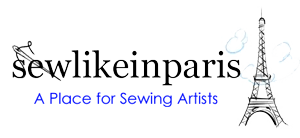

 Portland, Oregon,
Portland, Oregon, 